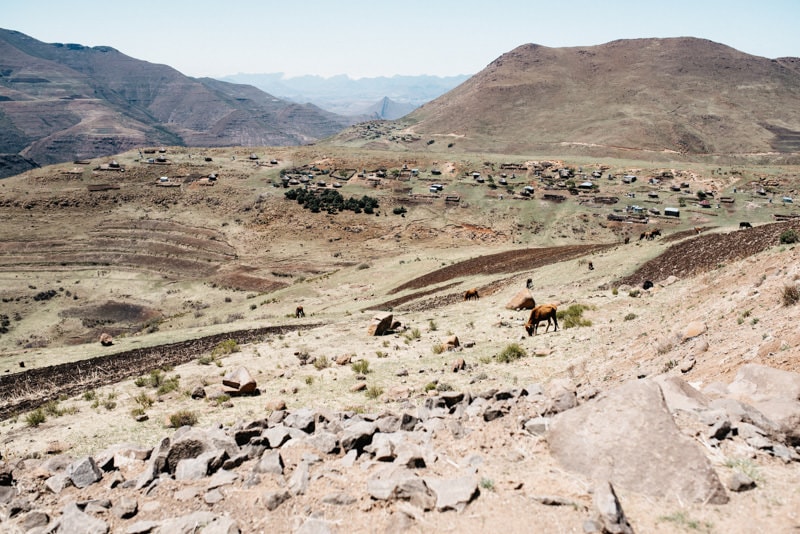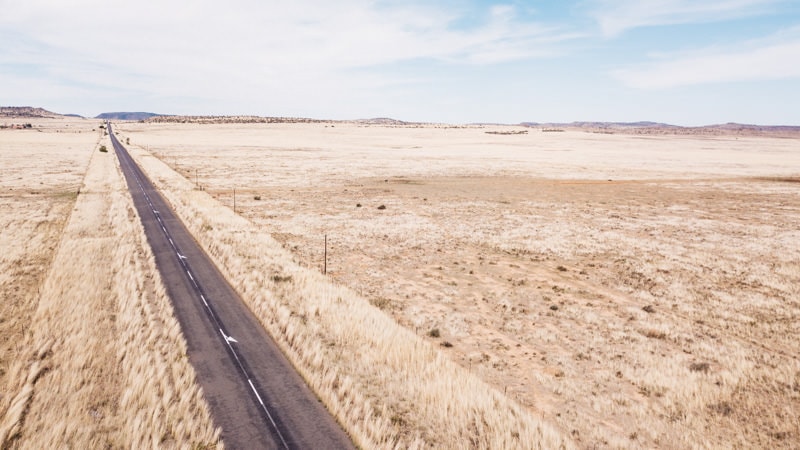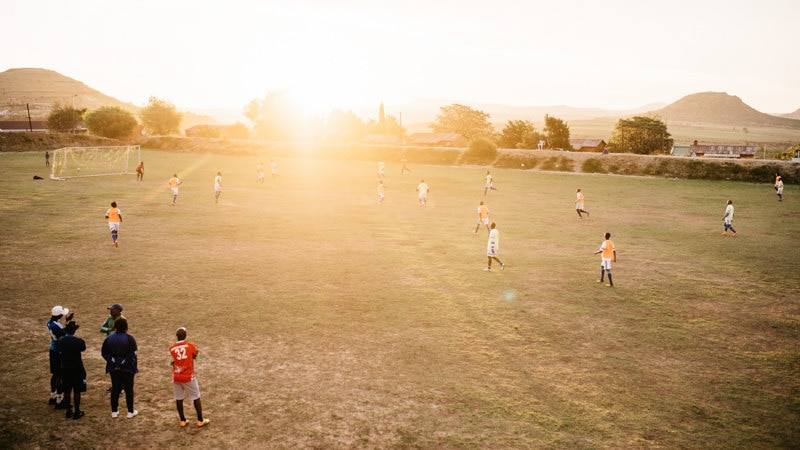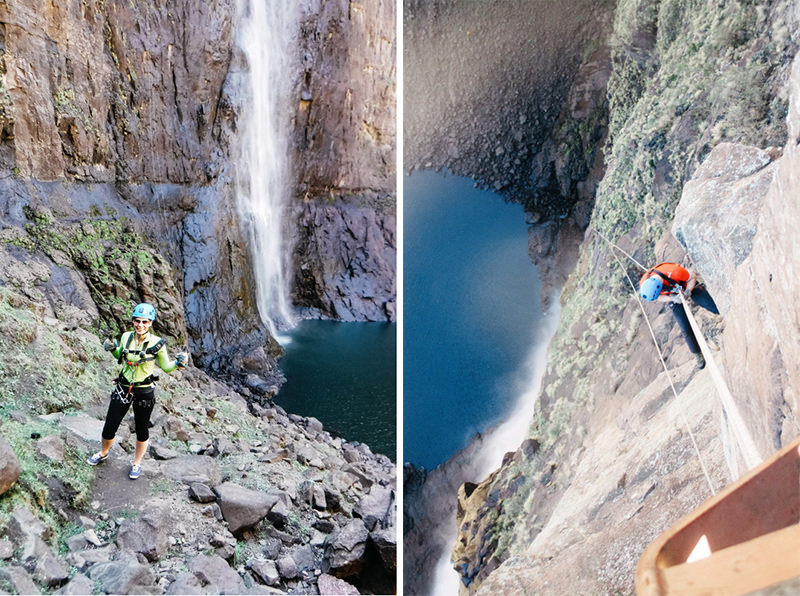After we had spent our first week as world travellers in South Africa, it was time for a little excursion to Lesotho. Lesotho is a country that we did not really know it existed and much less, where it is located until we started to plan our world tour. For some reason, we wanted to visit it and discovered an undiscovered land that we totally fell in love with.
Lesotho
Lesotho is a small kingdom in the middle of South Africa. It is a landlocked country and is surrounded by the regions Eastern Cape, Free State and KwaZulu-Natal (home to the famous Drakensberge). The country is coined by the Lesotho culture and its people – the Basotho that are primarily inhabitants of little villages wearing colorful clothes and blankets and riding horses through the alpine landscapes. Lesotho has its own currency, the Maloti, however, the South African Rand is generally accepted and the exchange rate is the same. English is widely spoken and, together with Sotho, one of the two official languages. For tourists, Lesotho has to offer three National Parks (Bokong Nature Reserve, Ts’ehlanyane Natioal Park and Sehlabathebe National Park) and lots of opportunities for Hiking as well as Pony Trekking.
1.000 kilometers until Lesotho
From Port Elisabeth we headed towards the African inland, knowing that we had almost 1.000 kilometers (620 miles) of driving ahead of us until our next destination: Semonkong Logde in the middle of nowhere somewhere in Lesotho. No matter whom in South Africa we told we were heading to Lesotho next, everybody kept on asking us why we wanted to go to Lesotho and what we were going to do there. Well, we actually don’t know ourselves what attracted us so much that we decided to go there, but Bianca really insisted on doing it. One reason might be that she loves abseiling and in Lesotho you can abseil the Maletsunyane Falls, one of the highest single dropping waterfalls in the Southern hemisphere. The abseil 205 meters (670 ft) down a waterfall received a Guinness World Record Certificate in 2005 for “the longest commercially operated single-drop abseil”. So, basically this is the story behind and the reason why we, all of a sudden, found ourselves stuck in the car for more than 8 hours driving through the absolute nothingness of South Africa. Along the first 400 kilometers we passed many little villages (that kind of villages where life takes place on the street and you ask yourself what people do the entire day because there is nothing you could think of and, more, what people do for living). Along the other 300 kilometers, there was basically really nothing more than land. The landscape did not even change, so we had moments where we were not even sure we were actually moving forward. This was the part where we crossed the South African region “Free State” – never heard of it? Well, we neither until we got there. It is an unexplored, unknown land that brings you directly to Maseru Bridge, one border crossing opportunity to Lesotho (open 24 hourse/day).
Maseru
Maseru is the capital of Lesotho and located directly at the border post Maseru Bridge. We stayed in Maseru for one night in the Kick4Life Hotel and Convention Center. It is located nicely on a hill overlooking the city. It is a social soccer project where young people are trained for a better life. All revenues of the hotel and the attached restaurant go to the foundation. Even David Beckham and the English National Team have already visited the place to teach the children soccer. Apart from being a very warmly welcomed stopover on our way to Semonkong, Maseru does not have a lot to offer. It is a crowded city, with too much traffic, lots of people and no real considerable architectural accomplishments.
Semonkong
The next day, we continued our long journey to Semonkong – which is another 2 hours drive from Maseru, up the mountains passing an unlimited number of villages. It was the most spectacular drive so far – not just because of the view but because you really get an impression of life in a Basotho village. We passed lots of fruit stands, a clinic that we just recognized as something hospital-like because it said “clinic” on top of the roof and even a beauty salon. Hundreds of cows and donkeys decorate the hills of Lesotho, which is very mountainous – the highest peak being 3.100 meters. After some little bit more than 2 hours of free cinema and passing the creepiest gravel road so far, we arrived at the Semonkong Lodge. As soon as we got out of the car, we were greeted by dozens of donkeys and welcomed by the friendly staff of the lodge. Right after we had arrived, we started with the training for our big 205 meter abseil the next day. We learned how to handle the rope and heard everything about the importance of straightening the feet (everything we learnt made more sense once we started with the abseil). The exercise spot for the abseil is 30 meters high and looks already pretty high. We had no idea how high 205 meters could possibly be, so there was no need to worry.
[Best_Wordpress_Gallery id=”37″ gal_title=”Semonkong 1″]
Maletsunyane Abseiling
The next morning at 8:00 AM our driver was already waiting to bring us to the Maletsunyane Falls. It’s an approximately 30-minute drive to the first viewpoint – the other side of the falls, so you get to enjoy a wonderful view on the falls and the spot where the abseiling will take place. From there you have to walk around 15 minutes to arrive at the starting point of the abseiling experience. Then the guides start to equip you with everything you need and then the first one can go down the 205 meters. In our case it was Bianca – females go first because as the rope gets wet from the waterfall, it becomes harder and harder to go down with little weight. After the ropes were ready, she started to make her way to the edge. It was crazy – the first look down the 200 meters all along the super-steep stony cliffs until the destination – the pool of the waterfall where the helmet of the guide waiting at the bottom is just a tiny yellow dot. The abseil takes around 20 minutes and is a ones-in-a-lifetime-experience. The first 30 meters of the abseil are a free fall part – so you don’t really have to use your feet, just turn around and enjoy the panoramic view into the deep gorge. That is followed by a rather long part that you jump down, land, jump down, land, jump down again and again and again. The last part is the toughest – although you are not that high anymore but the stones get wet, so there is basically no grip anymore. Sometimes you reach a little cliff where you can rest for a few seconds and then continue the journey down. After 20 minutes the adventure was over – we will remember it for the rest of our life though.
The tour ends with a 45 minutes hike out of the gorge up to the car. It is a very steep hike – 290 elevation gain in 45 minutes – but it offers a wonderful view. The guides have water and apple juice so you really get to enjoy the little break after half of the way. Abseiling Maletsunyane Falls is an experience that sounds crazy and looks creepy but as soon as you’ve done it you want to do it again and again.
Abseiling the Maletsunyane Falls:
Cost: 1.095 LSL / Rand per person (approximately 65 Euro)
Includes:
- Abseil training (30 meters – it takes place the afternoon before the actual abseil)
- The guides
- Drinks
- A certificate (Bianca was number 4.030 to do the abseil and Tom number 4.031)
- Pictures of the abseil (send to you by e-mail)
You can book the tour directly at the Semonkong Lodge Tour Desk once you arrive. We arrived on Thursday around 2:00 PM booked the tour and started with the training right away.
If you don’t feel like abseiling down a 205-meter waterfall, there is no need for you to avoid the Semonkong Lodge. It is a completely worth it experience and the activities offered go far beyond the abseiling. You can book a village tour to Semonkong, a donkey pub crawl, fishing tours and hikes in the surroundings (some even with an overnight stay).
Semonkong Village Tour
After we had successfully survived the abseiling, we decided to do the village tour to Semonkong in the afternoon. We talked to the barkeeper at the lodge the night before who is originally from Semonkong and told us a lot about the village and the people. Many of them are employed by the lodge, the remaining do have little businesses like pubs, cafes and souvenir shops that also profit from the tourists that come to the lodge. We were so curious about this village and really wanted to get to know more. You can walk to the town on your own – the town is just 10 minutes walk from the lodge – but we thought it was better to have a local guide. This turned out to be a good decision because our guide Ignatius walked us through the town for more than 2 hours and gave us a really good insight into village life in Lesotho. We learnt that primary school is free in Lesotho and so many towns have primary schools and all children receive basic education. Secondary schools are just in the bigger villages, that is why students sometimes have to walk many hours to get to school or they leave their family and move to a town with a school – living in a rental house without electricity. Not every family can afford this and this is also why many children leave school after primary school.
Ignatius brought us to the local supermarket that sells basically everything (we even discovered Red Bull which costs the same as in Austria!), which is the reason that people from many villages in the surroundings come to Semonkong to stock up their food reserves. We continued our way through the alleys of Semonkong passing lots of little tin shacks that people rent for very little money to sell clothes, fruit, jewelry and other stuff to earn money. The next stop was the Woodpecker Pub, the best pub in town and also a stop of the Donkey Pub Crawl, where we were welcomed by a dancing barmaid and very loud African music. The music comes out of a vintage jukebox – one song costs 1 Rand – so, you just insert a coin press the button. The pub only sells beer and only in big bottles (750 ml). We danced to the sounds of Africa and really enjoyed ourselves – Bianca was worried first that they did not have any 90s songs but after the second sip of beer she had forgotten about it. After the pub we went back to the lodge. It was a really cool tour and we really recommend it – don’t miss it if you ever come to Semonkong!
Cost of the Tour: 120 LSL / Rand per person (approximately 7,50 Euro) excluding tip for the guide.
[Best_Wordpress_Gallery id=”38″ gal_title=”Semonkong 2″]
Sani Pass
For our last day in Lesotho, we had to go back to South Africa first. The reason is that you can only manage the Sani Pass (2.764 m) with a 4×4 car. As we did not have such a car, we decided to do a day tour with a tour operator from Underberg in South Africa and, at the same time, get to enjoy the wonderful Drakensberge. Driving from Semonkong to Underberg (approximately 300 km/190 miles) took us 6 hours but it was totally worth it. We rent a little hut on a farm – farmstays are very popular in the Drakensberg region as the Durbanites (people from Durban) love to escape the city in summer and spend their vacation on self-catering farms in the Underberg area. Or hut was had a fully equipped kitchen, a bathroom and a bedroom. The view from the terrace on the Drakensberge was stunning.
There are three big tour operators offering the one-day Sani Pass Tour – Roof of Africa, Major Adventures and Sani Pass Tours. They all offer exactly the same tour and only differ regarding the price. We did the tour with Roof of Africa as we liked it that it is a small family-run business. When we got to Underberg, the tour for the next day was already full but they were very nice and organized a driver just for the two of us (for the same price as when you join a group). The tour started at the Himeville museum (5 km from Underberg), where our driver/guide Peter welcomed us. After a few formalities (for the border crossing), we started the drive up the Sani Pass. It is only 43 kilometers but it takes around 2,5 hours (including a few picture stops at the most scenic and panoramic viewpoints). We passed the Southern Drakensberge and learnt from Peter that they are called Drakensberge because they are formed like the back of a dragon. They are a hiking paradise and many tour operators offer guided walks. You can also hike by yourself but it is not really recommended for two reasons – the unpredictable weather and the snakes. Peter told us that there are puff adders and, even, cobras living in the Drakensberge up to 2.000 meters of elevation. Above this altitude you are not safe though – this is where the habitat of the mountain viper starts. We really enjoyed the wonderful view on the mountains and the animals. Peter spotted many birds and also an antelope. The animals are very shy and it is really hard to spot them – Peter told us, it is not so difficult if you see a moving stone it’s very likely to be an animal. Well yes, alright, we couldn’t see anything but he was highly motivated and really discovered many things with his eagle eyes. The ascend is slow and bumpy but the view gets more spectacular with every meter you make. You can see the Twelve Apostels (twelve basalt stone formations on top of the mountains), Giant’s Cup (a hollow between two peaks) and, the higher you get, the roof of the highest pub in Africa.
After more than two hours up the mountain and after we had also survived the last part – a serpentine road with twelve corners (whereof only seven are named), we reached the Lesotho border and, simultaneously, the Sani Pass. We were really lucky again because it was a completely clear day and we got to enjoy a perfect view. The day before we went up, it was very misty and the view limited. Our first stop was the highest point at Sani Pass, where it feels like you could see all over Lesotho. The second stop was a village close to Sani Pass, where we went to the house of a Basotho woman that had us try her home-made bread and beer. The bread was very soft and warm and tasted really good. The beer will most likely only make it to our memory as valuable intercultural experience – just because it did neither taste like beer nor good. Tom did not like it at all, that is why Bianca had to finish it – it made her sick and drunk. Thank God it was time for lunch in the highest pub in Africa, a very nice place with a picturesque view down the pass. After lunch, we started drive back down, which takes around 1,5 hours. We loved the tour – Peter was a really good driver/guide and the view from the top is payless.
Cost of the Tour: 780 Rand per person (approximately 50 Euro) excluding tip for the driver/guide
Includes:
- Driver/Guide
- Water and little snacks
[Best_Wordpress_Gallery id=”39″ gal_title=”Sani Pass”]
Our Overnight Stays
Semonkong Lodge is the perfect place for a two day-two night stay in Lesotho. It is a place to relax and it feels like you just landed at the end of the world (it felt more remote from home that New Zealand). It was a toughie to book it because we made the mistake to request a double room. As they did not have one available, they answered that there was no availability. As Bianca and her stubborn head had decided to do the abseiling, she decided not to accept the answer. So we asked if there was any space for two people available (dorm or whatever) and we were really lucky. Everything was available, just the double rooms were fully booked. So, if you want to stay at the Semonkong Lodge, don’t give up if they tell you they were fully booked. The room does not include any meals. They have all facilities for self-catering – huts with a stove, microwave and a table. They also have a tavern on-site, where you can have breakfast, lunch and dinner. If you plan to self-cater, make sure you bring food as the supermarket in Semonkong is just recognizable as a supermarket because of shelves with groceries. The food in the tavern is really good but prices are not really cheap.
We stayed at Blackbrook Farm for two nights. It is located around 5 km from Underberg in the middle of nothing with a wonderful view on the Drakensberge. It is very spacious (kitchen/living room, bathroom and a bedroom) and does not include any meals – it is a self-catering hut. We did the groceries in Underberg and prepared all meals by ourselves. The hut can easily accommodate four adults and a baby (we had a double bed, a bunk bed and a crib).









